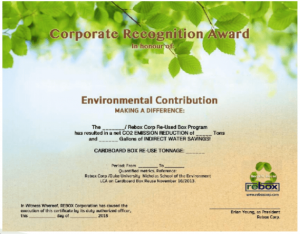Making a change to benefit the environment is fairly easy.
Tracking exactly how that change contributes to a healthier planet is a far more difficult task.
How are you supposed to know how much water you’re saving by taking shorter showers? Or the amount of waste you’re reducing by composting?
It’s next to impossible to know.
Fortunately, when it comes to making and tracking changes to your business’s workflow that contribute to a greener environment, Rebox has it covered.
Every single business that uses Rebox’s services gets a “Corporate Recognition Award,” a yearly scorecard tracking our partner’s contributions to creating a greener planet.

Rebox’s environmental certificate provides concrete numbers on how much waste, energy, and water a business has saved by reusing corrugated cardboard boxes (CCB) instead of recycling them.
Rebox tracks net greenhouse gas reduction and water savings, letting our partners see (and feel good about) the tangible environmental benefits our service provides.
And reusing old corrugated cardboard boxes (CCB) makes a much larger difference to the environment than you might expect.
In North America, tens of millions of tons of CCB waste is generated every year. A big chunk of that waste ends up in landfills, even though a large majority could have been reused.
Recycling CCB waste isn’t necessarily the answer, nor is it all that environmentally friendly, even though the word “recycle” tends to give that impression.
Enormous amounts of energy, water, and chemicals are used in the process to recycle CCB waste.
Not to mention the greenhouse gasses that are emitted during the recycling process, with so much more added because of a majority of North American CCB recycling is done in China.
Recycling puts 45x more greenhouse gasses into the atmosphere versus reusing CCB waste. Shockingly, if only a tenth of CCB waste in the United States alone was reused instead of recycled, greenhouse gas emissions would drop by 3000 metric tons every year.
Additionally, recycling CCB waste consumes 700x more water than the reusing process. For every ton of boxes reused instead of recycled, 18,450 gallons of water is conserved.
The reuse process is also ten times more energy efficient than recycling, since it’s mainly a manual process.
But don’t take our word for it. All of those facts were provided by the Nicholas School of the Environment at Duke University.
To veer away from all the science jargon, one bottling manufacturer in the West Coast of the United States can speak to the practical benefits of reusing CCB waste.
Not being able to manage their waste output and sustainability goals because of all the boxes they were recycling, this business decided to start reusing their CCB waste.
In a year, the manufacturer saw solid waste generation drop by 80%, saved 530 million gallons of water, and reduced greenhouse gas emissions by a whopping 160,000 metric tons of CO2.
All those impressive figures were compiled and recorded on the bottling manufacturer’s unique environmental certificate.
So, if you’re all about giving Mother Nature a hand and streamlining your business’s performance (really, who isn’t?) then maybe it’s time you got a Corporate Recognition Award of your own.